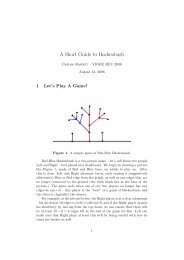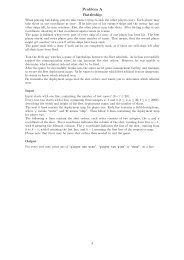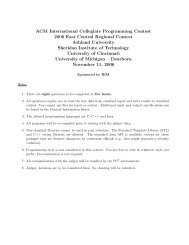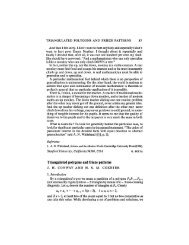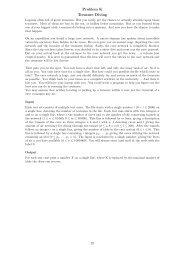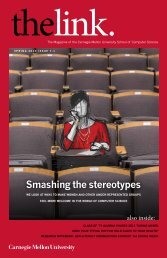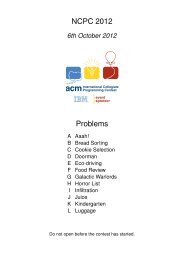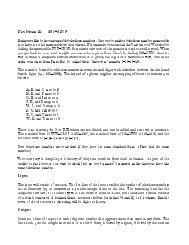Review1 of Liber De Ludo Aleae (Book on Games of Chance) by ...
Review1 of Liber De Ludo Aleae (Book on Games of Chance) by ...
Review1 of Liber De Ludo Aleae (Book on Games of Chance) by ...
Create successful ePaper yourself
Turn your PDF publications into a flip-book with our unique Google optimized e-Paper software.
Review 1 <str<strong>on</strong>g>of</str<strong>on</strong>g> Abraham de Moivre’s A Method <str<strong>on</strong>g>of</str<strong>on</strong>g> approximating the Sum <str<strong>on</strong>g>of</str<strong>on</strong>g> Terms <str<strong>on</strong>g>of</str<strong>on</strong>g> the Binomial<br />
(a+b) n …From The Doctrine <str<strong>on</strong>g>of</str<strong>on</strong>g> <strong>Chance</strong>s<br />
1. Biographical Notes<br />
According to Isaac Todhunter in his text, A History <str<strong>on</strong>g>of</str<strong>on</strong>g> the Mathematical Theory <str<strong>on</strong>g>of</str<strong>on</strong>g> Probability2:<br />
“Abraham de Moivre was born at Vitri, in Champagne, in 1667. On<br />
account <str<strong>on</strong>g>of</str<strong>on</strong>g> the revocati<strong>on</strong> <str<strong>on</strong>g>of</str<strong>on</strong>g> the edict <str<strong>on</strong>g>of</str<strong>on</strong>g> Nantes3, in 1685, he took shelter<br />
in England, where he supported himself <strong>by</strong> giving instructi<strong>on</strong> in<br />
mathematics and answers to questi<strong>on</strong>s relating to chances and annuities.<br />
He died at L<strong>on</strong>d<strong>on</strong> in 1754…<str<strong>on</strong>g>De</str<strong>on</strong>g> Moivre was elected a Fellow <str<strong>on</strong>g>of</str<strong>on</strong>g> the<br />
Royal Society in 1697…It is recorded that Newt<strong>on</strong> himself, in the later<br />
years <str<strong>on</strong>g>of</str<strong>on</strong>g> his life, used to reply to inquirers respecting mathematics in<br />
these words: ‘Go to Mr. <str<strong>on</strong>g>De</str<strong>on</strong>g> Moivre, he knows these things better than I<br />
do’…”<br />
<str<strong>on</strong>g>De</str<strong>on</strong>g> Moivre is well known for the theorem:<br />
n<br />
[cos( θ ) + isin(<br />
θ )] = cos( nθ<br />
) + isin(<br />
nθ<br />
)<br />
2. Review <str<strong>on</strong>g>of</str<strong>on</strong>g> the article<br />
This review relates to a supplementary article entitled A Method <str<strong>on</strong>g>of</str<strong>on</strong>g> approximating the Sum <str<strong>on</strong>g>of</str<strong>on</strong>g> the Terms <str<strong>on</strong>g>of</str<strong>on</strong>g><br />
the Binomial (a+b) n expanded into a Series, from whence are deduced some practical Rules to estimate<br />
the <str<strong>on</strong>g>De</str<strong>on</strong>g>gree <str<strong>on</strong>g>of</str<strong>on</strong>g> Assent which is to be given to Experiments (referred to as the Approximatio), which appears<br />
in later editi<strong>on</strong>s (after 1733) <str<strong>on</strong>g>of</str<strong>on</strong>g> Abraham <str<strong>on</strong>g>De</str<strong>on</strong>g> Moivre’s text <strong>on</strong> probabilities, The Doctrine <str<strong>on</strong>g>of</str<strong>on</strong>g> <strong>Chance</strong>s, first<br />
published in 1718.<br />
<str<strong>on</strong>g>De</str<strong>on</strong>g> Moivre’s mathematical presentati<strong>on</strong> in the Approximatio begins with a discussi<strong>on</strong> relating to<br />
approximating the ratio <str<strong>on</strong>g>of</str<strong>on</strong>g> the middle term <str<strong>on</strong>g>of</str<strong>on</strong>g> the binomial (1+1) raised to very large n, to the sum <str<strong>on</strong>g>of</str<strong>on</strong>g> all<br />
terms (2 n ). It is indicated that this approximati<strong>on</strong> was developed several years earlier. As a result <str<strong>on</strong>g>of</str<strong>on</strong>g><br />
c<strong>on</strong>tributi<strong>on</strong>s from James Stirling, it was found that the approximate ratio could be written as<br />
where c is the circumference <str<strong>on</strong>g>of</str<strong>on</strong>g> a circle with radius equal to 1. The value <str<strong>on</strong>g>of</str<strong>on</strong>g> c is then 2π.<br />
<str<strong>on</strong>g>De</str<strong>on</strong>g> Moivre next states:<br />
2<br />
nc<br />
1 Submitted for STA 4000H under the directi<strong>on</strong> <str<strong>on</strong>g>of</str<strong>on</strong>g> Pr<str<strong>on</strong>g>of</str<strong>on</strong>g>essor Jeffrey Rosenthal.<br />
2 A History <str<strong>on</strong>g>of</str<strong>on</strong>g> the Mathematical Theory <str<strong>on</strong>g>of</str<strong>on</strong>g> Probability, page 78, <strong>by</strong> Isaac Todhunter, Chelsea Publishing Co., New<br />
York (1965 unaltered reprint <str<strong>on</strong>g>of</str<strong>on</strong>g> the First Editi<strong>on</strong>, Cambridge 1865).<br />
3 The Edict <str<strong>on</strong>g>of</str<strong>on</strong>g> Nantes was a proclamati<strong>on</strong> <strong>by</strong> King Henry IV <str<strong>on</strong>g>of</str<strong>on</strong>g> France and Navarre, guaranteeing civil and religious<br />
rights to the Huguenots.<br />
28




